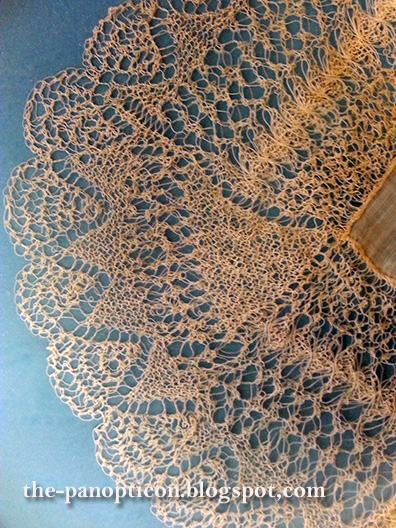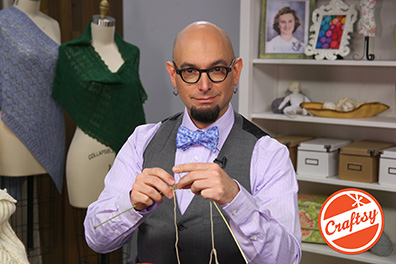This morning I had a bit of an adventure. One of my friends here in Chicago teaches theatrical costume design, and was in need of a male fitting model for a class on pattern making. Would I be interested in the position, in exchange for the chance to audit the class?
This friend knows I have Sewing Envy, you see, and that pattern making is a skill I covet but don't possess. After a check of my travel schedule, I sent back an eager YES, PLEASE. So this morning, with notebook and pencils, I headed to the first meeting.
The costume shop was exactly what I expected it would be. Crowded. The arts never get enough space. Nor was it pretty in the conventional sense. Workrooms, except workrooms staged for display in craft magazines, seldom are.
Most of the floor was crammed with the requisite tables: high for cutting and pressing, lower for sitting and sewing. At the far end, costume sketches for the next production covered most of the wall. The other walls were stacked with supply bins: BRAID, BONE TAPE, HORSEHAIR, SNAPS. Two female forms, decked in day dresses in the style of the late Edwardian era, stood right and left like sentinels.
Again, not a conventionally pretty room. But if, like me, you love the possibility inherent in thread and snaps; and if, like me, you love to see the how behind beautiful things; it would be difficult to come up with a more fascinating space. I was so fascinated, in fact, that I forgot professional irons in a setting like this are usually a) always on and b) very hot. So I set my notebook on fire. But only a little bit. I don't think anybody noticed.
My friend is a top-notch teacher. The students had already been at work on their first pattern drafts (a female bodice, a skirt, a pair of women's trousers) and for the first hour of the class I watched him talk through each draft, making helpful suggestions and gentle, but firm, corrections.
It was difficult not to turn green with envy. They're all so young, these students. They have it all in front of them. They have so much opportunity, and so little responsibility. I had to battle a phalanx of If only... and Why didn't I? thoughts to keep my mind on the lesson.
Still, better late than never. Halfway through the second skirt draft I had my lightbulb moment. I've tried to teach myself pattern drafting many times without success. Suddenly–ZAP!–the measurements connected to the drafting instructions connected to the lines on the paper. I was so happy I wanted to dance. But you can't dance in a room crowded with cutting tables unless you get up on one of the cutting tables, and as this was my first visit I was trying to play it cool.
Not long after, I noticed (over the teacher's shoulder, at the far end of the room) a piece of fabric framed under glass. And even at thirty feet I recognized it as a handkerchief edged with knitted lace.
When we took a break, I made a beeline for it. Here are a few quick photographs made with my phone.

The framing job is, to be diplomatic, unfortunate. The handkerchief has been folded in four places to make it fit the frame, which is too small. There are neither spacers nor matte to give the textile room to breathe. The backing paper is probably not acid free, and neither is the label smashed between the glass and the edging. The acid in paper can, will, and does discolor fabric it touches. Also, I very much doubt the glass is treated to block out UV rays, which do nasty, nasty things to fiber–especially delicate fiber.
In other words, if you have such a treasure in your possession and you wish to frame it, this is an object lesson in what not to do. In other words, if you have such a treasure in your possession and you frame it like this, I will kick you in the nuts.
But enough griping. It was there, and it was gorgeous, and here's some more about it.
The work is super-fine. The fiber looks like cotton and is the weight of very fine sewing thread–closer to embroidery floss than, say, buttonhole twist. And the gauge is minute. I would venture to guess that the needles used would have been in the 000000 (that's six aughts) family.
The edge of the woven center was prepared with a rolled edge (in itself a feat of fine sewing) and the edging was then attached with tiny whip stitches in the same thread used for knitting. I can't help wondering whether the knitter made the center first and knit the edging to fit; or knit and blocked the edging and then sewed a center to fit. My guess is the latter, unless she was a masochist.
I also need to look at this again, closely and with more time, to try to find the start/end point. I tried for about three minutes, and couldn't. It might be buried under one of the folds. For a moment I wondered whether it might have been knit from the center outwards, but it's clear from the grain of the fabric (mostly easiy visible in the plain garter stitch passages) that it was knit sideways, across the short width of the fabric.
One of the fascinating design choices is the corner treatments. Corners, as I always say in my Lace Edgings classes, can be tricky and deserve special attention. Usually, the trick is in making the continuous pattern swing attractively around the angle. Here, the knitter altered the pattern to suit the corners.

And while I don't love the sight of an acidic label snuggling a precious piece of knitting, I do love that there is, in fact, a label. Here's what it tells us, verbatim.
HANDKERCHIEF WAS MADE BY MRS. CONRAD PERRY, RIVERSIDE, TEXAS, AT THE AGE OF 76 YEARS, IN 1834. NUMBER 300 THREAD KNITTED ON SMALL STEEL NEEDLES, AND GIVEN TO THE WOODLAWN HISTORICAL SOCIETY ON AUGUST 20, 1941 BY MRS. LETTIE MC CLARY, FORMERLY OF 6328 KENWOOD AVENUE, NOW A GUEST IN THE EASTERN STAR HOME, ROCKFORD, ILL.
I raise my eyebrows at that date. But Mrs. Perry, I salute you. Your work humbles me. And Mrs. McClary, I thank you for preserving this for us to see. I pray your days at the Eastern Star Home were pleasant, and ended peacefully.
Speaking of Lace Edgings...
My first online class for Craftsy, "Heirloom Lace Edgings," will launch early next week. It's an action-packed course: we play with lace edgings that are sewn on, lace edgings that are knitted on, and lace edgings that are knit at the same time as the center they decorate. So many possibilities...
Watch this space (or my Twitter and/or Facebook feeds) for the announcement. I had an absolutely ball working with the Craftsy crew and staff to make it happen, and I hope you'll enjoy taking it as much as I enjoyed making it. Here's an Official Photo of me on the set, looking all kinds of serious...with my beloved grandmother watching over my shoulder. She hated knitting, but I hope she'd be proud.
